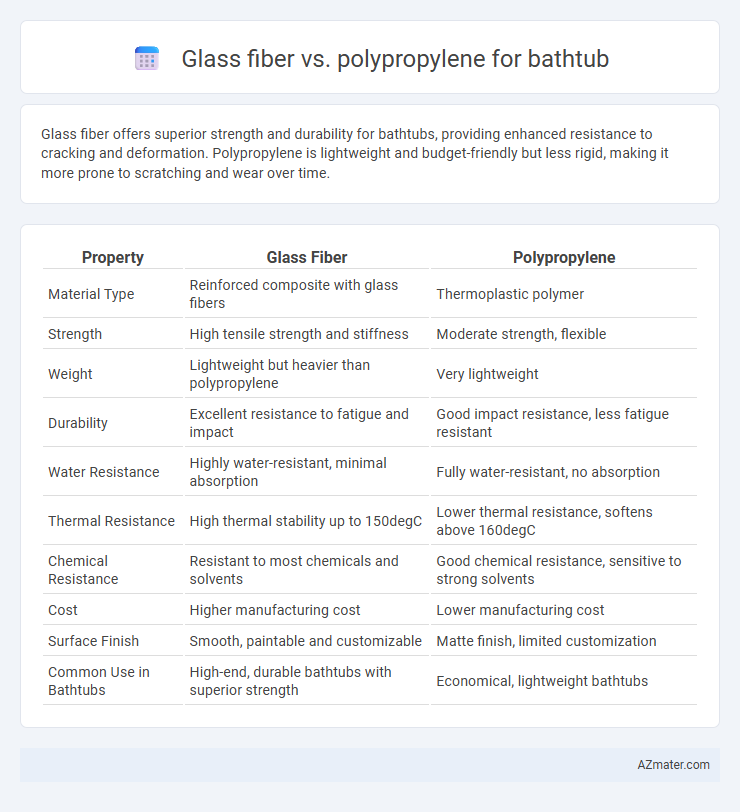Glass fiber offers superior strength and durability for bathtubs, providing enhanced resistance to cracking and deformation. Polypropylene is lightweight and budget-friendly but less rigid, making it more prone to scratching and wear over time.
Table of Comparison
| Property | Glass Fiber | Polypropylene |
|---|---|---|
| Material Type | Reinforced composite with glass fibers | Thermoplastic polymer |
| Strength | High tensile strength and stiffness | Moderate strength, flexible |
| Weight | Lightweight but heavier than polypropylene | Very lightweight |
| Durability | Excellent resistance to fatigue and impact | Good impact resistance, less fatigue resistant |
| Water Resistance | Highly water-resistant, minimal absorption | Fully water-resistant, no absorption |
| Thermal Resistance | High thermal stability up to 150degC | Lower thermal resistance, softens above 160degC |
| Chemical Resistance | Resistant to most chemicals and solvents | Good chemical resistance, sensitive to strong solvents |
| Cost | Higher manufacturing cost | Lower manufacturing cost |
| Surface Finish | Smooth, paintable and customizable | Matte finish, limited customization |
| Common Use in Bathtubs | High-end, durable bathtubs with superior strength | Economical, lightweight bathtubs |
Introduction to Bathtub Materials: Glass Fiber and Polypropylene
Glass fiber and polypropylene are prominent materials used in bathtub manufacturing, each offering distinct properties that influence durability and maintenance. Glass fiber reinforced plastic (FRP) provides enhanced strength, lightweight characteristics, and resistance to cracking and chipping. Polypropylene, a thermoplastic polymer, is known for its flexibility, chemical resistance, and affordability, making it a practical choice for many homeowners.
Overview of Glass Fiber Bathtubs
Glass fiber bathtubs feature a composite material made from fine glass fibers embedded in a resin matrix, offering superior strength and durability compared to polypropylene. These bathtubs are lightweight yet resistant to cracking, chipping, and fading, making them ideal for long-term use. Their smooth, glossy finish provides a high-end aesthetic while ensuring thermal insulation and easy maintenance.
Overview of Polypropylene Bathtubs
Polypropylene bathtubs are lightweight, durable, and resistant to chemical corrosion, making them a practical choice for modern bathrooms. Their non-porous surface prevents mold and mildew growth, offering superior hygiene compared to glass fiber tubs. While glass fiber bathtubs provide rigidity and a smooth finish, polypropylene models excel in flexibility and impact resistance, ensuring long-term durability and easier maintenance.
Durability Comparison: Glass Fiber vs Polypropylene
Glass fiber bathtubs exhibit superior durability due to their resistance to cracking, chipping, and heat, maintaining structural integrity over long-term use. Polypropylene bathtubs, while lightweight and resistant to chemical corrosion, tend to be less durable under heavy impact and may degrade faster with prolonged exposure to UV rays. This makes glass fiber a preferred option for durability-focused bathtub installations requiring long-lasting performance.
Weight and Installation Differences
Glass fiber bathtubs are significantly heavier than polypropylene models, with weights typically ranging from 60 to 100 pounds compared to polypropylene's 30 to 50 pounds. The increased weight of glass fiber requires more robust support structures during installation, often necessitating professional help. Polypropylene bathtubs, being lighter and more flexible, allow for easier, faster installation and can often be handled by a single installer.
Cost Analysis of Glass Fiber and Polypropylene Bathtubs
Glass fiber bathtubs typically cost between $400 and $900 due to the material's durability and ease of molding, while polypropylene options range from $300 to $700, offering a more budget-friendly choice but less structural strength. The manufacturing process for glass fiber involves layering resin and glass strands, increasing labor and production expenses compared to the injection molding used for polypropylene. Long-term cost considerations include the higher maintenance resistance of glass fiber, which may reduce replacement or repair expenses versus polypropylene's susceptibility to scratches and discoloration.
Design and Aesthetic Flexibility
Glass fiber offers superior design and aesthetic flexibility for bathtubs due to its ability to be molded into complex shapes and smooth, high-gloss finishes. Polypropylene, while durable and lightweight, has limited design options with simpler forms and a matte or semi-gloss finish. The enhanced moldability of glass fiber enables more intricate, customizable designs tailored to modern bathroom aesthetics.
Maintenance and Cleaning Requirements
Glass fiber bathtubs require regular cleaning with non-abrasive, mild detergents to maintain their glossy finish and prevent surface scratches, while avoiding harsh chemicals that can weaken the resin. Polypropylene tubs offer superior resistance to stains and dents, allowing easier maintenance with simple soap and water, and they do not yellow or degrade quickly under frequent cleaning. Both materials demand routine upkeep, but polypropylene is generally more forgiving and cost-effective in terms of long-term cleaning and maintenance efforts.
Environmental Impact and Sustainability
Glass fiber bathtubs typically have a higher environmental impact due to energy-intensive manufacturing processes and non-biodegradable resin use, while polypropylene bathtubs offer superior sustainability through recyclability and lower carbon footprint production. Polypropylene's lightweight nature reduces transportation emissions, enhancing its eco-friendly profile compared to glass fiber composites. Both materials resist water damage, but polypropylene's potential for recycling and reduced environmental burden makes it a preferable choice for sustainable bathroom design.
Choosing the Right Bathtub Material for Your Needs
Glass fiber bathtubs offer superior strength, durability, and a glossy finish, making them ideal for high-traffic bathrooms requiring long-lasting performance. Polypropylene bathtubs provide lightweight, cost-effective options with good chemical resistance and flexibility, suitable for budget-friendly and easy-to-install solutions. Selecting between glass fiber and polypropylene depends on balancing durability, maintenance, aesthetic preferences, and installation requirements to meet your specific bathroom needs.

Infographic: Glass fiber vs Polypropylene for Bathtub
 azmater.com
azmater.com